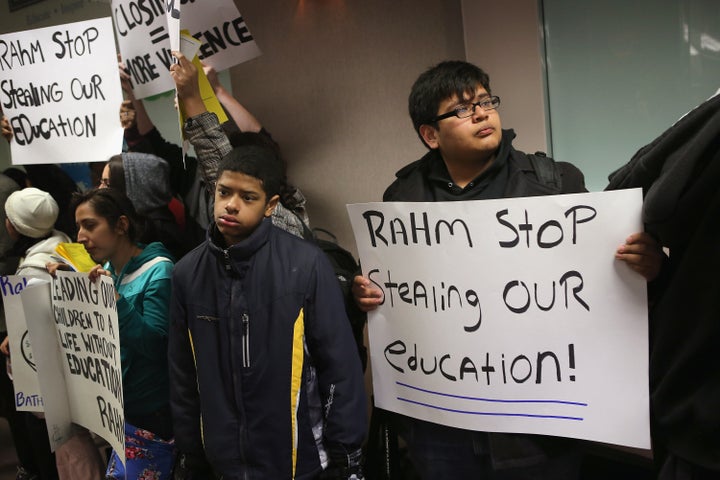
Mayors and reformers would have us believe that school closures, like the 54 recently announced in Chicago, will save districts money while improving outcomes for students who are moved out of "failing" schools. The problem is, districts have been closing schools for many years -- in Chicago, for over a decade -- and it's clear that they won't accomplish these goals. In fact, the opposite has happened.
According to the Consortium for Chicago School Research, a leading research authority on education in Chicago, Arne Duncan's closure of dozens of schools as part of Renaissance 2010 provided no benefit to students, since the vast majority were simply transferred from one low-performing school to another. A recent brief on closures from CReATE notes actual damage - transferred students, who felt stigmatized, had lower test scores and higher risks of dropping out. The Consortium did find improved outcomes for the six percent who landed in academically strong schools and found supportive teachers, but that doesn't help the 94 percent who stagnated or lost ground, nor make up for the disruption to those children and families. It does not compensate for the spikes in violence when established gang routes were disrupted, nor for the inability of other schools to cope with repeated influxes of new, struggling students (some moved four times in just three years).
Moreover, predicted cost savings largely failed to materialize. Of 77 CPS schools closed in the past decade, 80 percent now house other schools. And, as CReATE documents, prior CPS predictions of budget shortfalls were wildly overestimated, while assumptions regarding its ability to lease out buildings and, thus, save money on closed schools, fell far short of the mark. Barbara Byrd-Bennett's talk of "right-sizing the district" is hard to reconcile with this reality.
The damage isn't limited to Chicago. In Washington, D.C., where Chancellor Kaya Henderson recently announced the impending closure of 15 more schools, impacts from prior closures are no more promising. One of Henderson predecessor Michelle Rhee's first decisions as Chancellor of DCPS was the closure of 23 "low-performing" and "under-enrolled" schools. Parents and policymakers were told that closing the schools would save the district $23 million that could be used to hire more teachers and enact new programs, and that students affected could move to better schools. After the closures, Rhee reported that the total cost had been less than $10 million. However, an audit put the pricetag at closer to $40 million -- no savings, lots of unanticipated costs -- not even accounting for the loss of an estimated $5 million in revenue when parents switched to charter schools as a result of the closures, nor the added burden to families of transporting children to farther-away schools. Moreover, on average, students' new schools had even lower odds of making Annual Yearly Progress under No Child Left Behind than the schools they were moved out of. The closures simply resulted in longer commutes, higher costs for struggling families, and fewer incentives for disengaged students to stay in school.
The thousands of Chicagoans rallying in opposition to the closings on Wednesday were not demanding the unreasonable. Parents, students, teachers, and principals are right to seek policy decisions based on evidence, not the popularity of current reforms, and to put a stop to those that harm students, schools, and their communities.
Districts can make better use of their schools in ways that are backed by evidence, like turning them into full-service community schools. Chicago, home to 150 of these already, knows their benefits; it has seen how empty space can be used to build school-based health centers that reduce absenteeism and improve engagement; and how afterschool and summer programs increase parental engagement and graduation rates. These neighborhood hubs can incorporate high-quality prekindergartens, which, unlike school closures, boosted low-income DCPS students' third grade test scores. These options also represent a draw for the middle-class families that both Chicago and Washington are working so hard to bring into their school systems.
With so many terrific options to choose from, this should be a no-brainer for both districts. Let's hope they recognize it.
This blog is co-authored by Kevin Kumashiro, professor at the University of Illinois at Chicago, president-elect of the National Association for Multicultural Education, and author of the new book, "Bad Teacher!: How Blaming Teachers Distorts the Bigger Picture."